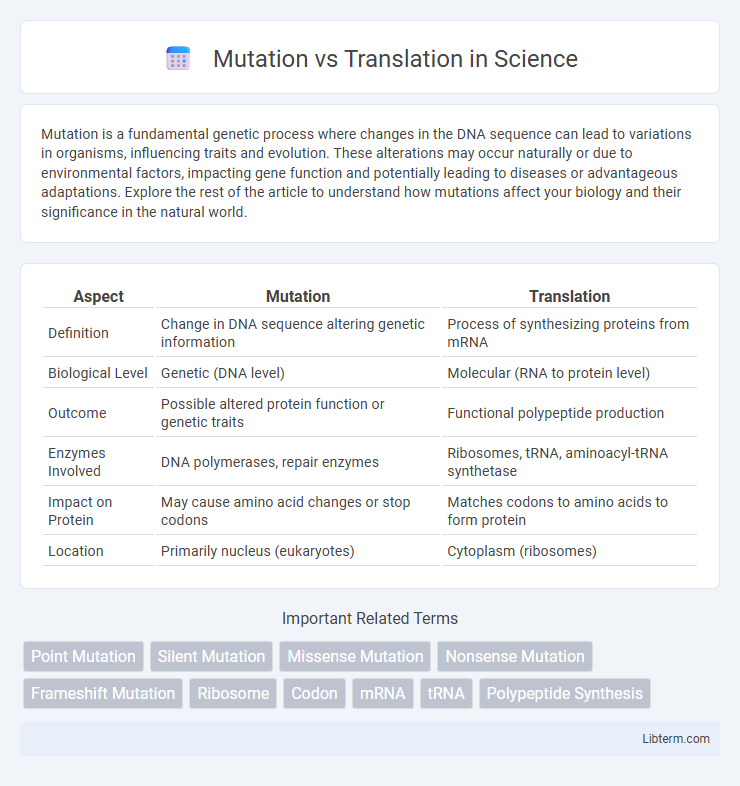Mutation is a fundamental genetic process where changes in the DNA sequence can lead to variations in organisms, influencing traits and evolution. These alterations may occur naturally or due to environmental factors, impacting gene function and potentially leading to diseases or advantageous adaptations. Explore the rest of the article to understand how mutations affect your biology and their significance in the natural world.
Table of Comparison
| Aspect | Mutation | Translation |
|---|---|---|
| Definition | Change in DNA sequence altering genetic information | Process of synthesizing proteins from mRNA |
| Biological Level | Genetic (DNA level) | Molecular (RNA to protein level) |
| Outcome | Possible altered protein function or genetic traits | Functional polypeptide production |
| Enzymes Involved | DNA polymerases, repair enzymes | Ribosomes, tRNA, aminoacyl-tRNA synthetase |
| Impact on Protein | May cause amino acid changes or stop codons | Matches codons to amino acids to form protein |
| Location | Primarily nucleus (eukaryotes) | Cytoplasm (ribosomes) |
Understanding Genetic Mutation
Genetic mutation refers to a permanent alteration in the DNA sequence, affecting the organism's genetic code and potentially leading to changes in protein structure or function. Translation is the cellular process where the ribosome synthesizes proteins by decoding messenger RNA (mRNA) sequences, translating nucleotide information into amino acid chains. Understanding genetic mutation involves analyzing how alterations in DNA impact the accuracy and efficiency of translation, influencing phenotypic expression and evolution.
Defining Translation in Molecular Biology
Translation in molecular biology is the process by which ribosomes synthesize proteins using messenger RNA (mRNA) as a template. This involves decoding the nucleotide sequence of mRNA into a specific sequence of amino acids, forming polypeptide chains essential for cellular function. The translation machinery relies on transfer RNA (tRNA) molecules to match codons in mRNA with their corresponding amino acids, ensuring accurate protein assembly.
Key Differences: Mutation vs Translation
Mutation involves a permanent alteration in the DNA sequence, affecting genetic information at the molecular level, while translation is the process by which ribosomes synthesize proteins based on the mRNA sequence. Mutations can impact the amino acid sequence by causing changes such as missense, nonsense, or frameshift mutations, whereas translation decodes the mRNA codons into a specific polypeptide chain without altering the nucleotide sequence. Understanding the distinction between mutation and translation is crucial for grasping how genetic information is stored versus how it is expressed as functional proteins.
Types of Genetic Mutations
Genetic mutations include several types such as point mutations, insertions, deletions, and frameshift mutations, each altering the DNA sequence differently. Point mutations involve a single nucleotide change, while insertions and deletions add or remove nucleotides, potentially causing frameshift mutations that disrupt the entire downstream protein translation. These mutations directly impact translation by affecting mRNA codons, leading to changes in the amino acid sequence and potentially altering protein function.
The Process of Protein Translation
Protein translation is the cellular process where ribosomes synthesize proteins by decoding messenger RNA (mRNA) sequences into amino acid chains. During translation, transfer RNA (tRNA) molecules deliver specific amino acids to the growing polypeptide based on codon-anticodon pairing, ensuring accurate protein assembly. Mutations in the mRNA sequence can alter codons, potentially impacting the translation process by producing dysfunctional proteins or truncated polypeptides.
Effects of Mutations on Protein Synthesis
Mutations in DNA sequences can lead to changes in mRNA codons during transcription, directly affecting the translation process and altering the amino acid sequence of proteins. Missense mutations replace one amino acid with another, potentially disrupting protein structure and function, while nonsense mutations create premature stop codons, resulting in truncated, nonfunctional proteins. Silent mutations do not change the amino acid sequence but can influence translation efficiency and protein folding, impacting overall protein synthesis.
Mutation: Causes and Consequences
Mutation involves changes in the DNA sequence caused by factors such as radiation, chemical exposure, or replication errors, leading to alterations in genetic information. These changes can result in protein malfunction, genetic disorders, or evolutionary adaptations depending on the mutation's nature and location. Unlike translation, which synthesizes proteins from mRNA, mutations directly impact the DNA blueprint, potentially causing significant phenotypic effects.
Translation: Steps and Regulation
Translation is the process by which ribosomes synthesize proteins using mRNA as a template, involving three main steps: initiation, elongation, and termination. During initiation, the ribosome assembles around the start codon on mRNA; elongation adds amino acids by matching tRNA anticodons with mRNA codons; termination occurs when a stop codon is reached, releasing the completed polypeptide. Translation is tightly regulated through mechanisms such as initiation factor activity, availability of charged tRNAs, and feedback from cellular stress pathways to ensure precise protein synthesis.
Mutation and Translation in Genetic Diseases
Mutations in DNA sequence often lead to genetic diseases by altering the genetic code, which can disrupt protein function during translation. Translation is the process where ribosomes convert mRNA sequences into proteins, and errors in this step due to mutated mRNA can result in defective or nonfunctional proteins. Many genetic disorders, such as cystic fibrosis and sickle cell anemia, arise from mutations that affect the translation of critical proteins necessary for normal cellular function.
Mutation vs Translation: Summary Table
Mutation involves changes in the DNA sequence, leading to potential alterations in genetic information, while translation is the process by which ribosomes synthesize proteins based on mRNA sequences. The summary table highlights key differences: mutation affects the nucleotide sequence and can be permanent or temporary, whereas translation converts the genetic code into amino acid chains without altering DNA. Understanding these distinctions is essential for fields like genetics, molecular biology, and biotechnology, where DNA modifications and protein synthesis play critical roles.
Mutation Infographic

 libterm.com
libterm.com